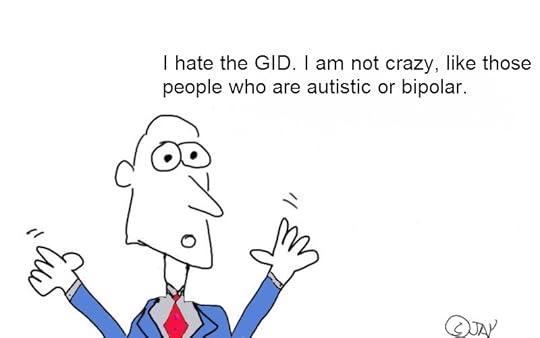Jay Sennett's Blog, page 4
June 12, 2017
Transsexual Man Becomes the Subject of His Life
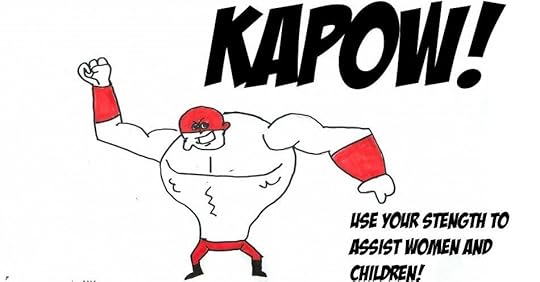 A cartoon drawn by Jay Sennett, 2012.
A cartoon drawn by Jay Sennett, 2012.Below is a condensed version of the introduction to my book Self-Organizing Men.
Self-Organizing Men draws its title from the work Chilean biologists Humberto Maturana and Francisco Varela, who, in 1973, used the term autopoises to describe biological systems. Literally meaning auto self-creation, I felt that term described my evolution as a transsexual white man. My “self”– that collection of stories I tell about myself in mind – shifts and changes with input from all my interactions within my chosen worlds.
With new information my stories about myself have and do change over time with my self organizing and reorganizing. This reality doesn’t surprise me. Changing genders has altered both the arc and meaning of my life as well as provided me with experiences that are contradictory. I am a without a penis, a man who used to be a lesbian, girl, female.
These histories and facts do not resolve into neat theories. Manhood for me has been a messy and delightful business filled with complexity, partiality and vulnerability.
A part of me has hoped for a place and time where I would stop being sucked further into the vulnerability that exists at the heart of conscious masculinity. I wanted to continue to objectify myself as a man the way I had objectified men before hormones.
Even after starting hormones I struggled with all the incoming information from my bodies, family, friends, the world. My opinion suddenly mattered. Women, those humans who most arouse me, flirted more but drew me in less. What was worse is that they had become very, very wary of me.
Of course they would be afraid of me, I told myself at the time, I had become a straight, white dude – everything that was wrong with the world. Despite my work around transsexual and transgender activism, sex with women proved to be my Everest. Having sex as a “transsexual man” or “a man who used to be a woman” did not work for me. I wanted to have sex as a man with a woman.
But how could I have sex as an objectifier with people who had been so long objectified by folks like me?
In early 2002 I began dating the woman who would become my wife. Ms. H. is a very passionate, intelligent women who, quite simply and by her own admission, “like fucking guys.” Her openness to me as a man – unqualified and unapologetic – astonished me. With her I felt like the teen-aged boy I had never been, the one who thinks he has discovered sex for the very first time. I fell for Ms. H. very hard and fast.
One night we were out at a very crowded club queued up at the bar. I people watched to pass some time and saw a very football-player sized white man about three heads over. If there ever was a man who was The Man, he was it. He had his face turned away from me with his arm around a white woman, a Barbie. I’m sure I thought something mean-spirited in my head — breeder, airhead, dickhead.
But then he turned back to face the woman and me. He looked as lovestruck as I felt. Passion and tenderness dripped off his face like melting ice cream. For reasons I still cannot explain, my sense of self radically reorganized itself in that moment. I became the subject of my life. The passionate hard-on I felt for Ms. H. as a man was mirrored in Mr. Footplayer’s face. I was him. He was me.
After six years on hormones, I had finally stepped into the center of my masculinity. Sexual love was my rite of manhood.
Since then I have scoured bookstores looking for books where I might find myself, books that discussed masculine vulnerability; penises; white privilege; living with all of our internal opposition; childhood; how to hold all of our paradoxes deep within our hearts.
I didn’t find that book, so I decided to create one.
The authors in Self-Organizing Men have exceeded my expectations. An anthology is like a jazz-ensemble, and I am thrilled at the concert you have in your hands.
Listen to each author as they describe what conscious masculinity means for them. They may riff off each other or may explore directions that seem out-of-step with the tempo of this book. That is fine. Men – broadly defined to include anyone willing to assume use of the term as meaningful to them – are a varied, contrary lot. I say this mostly for me, since I was the one who tried to goosestep to a kind of bizarre groupthink around notions of purity and how I had failed the feminist movement because I had become a man.
I wrote this book for me, so that I might continue to see myself, or at least try, in the eyes of all men. The authors have each given me a gift, not only through their words, but for also taking a chance on me, a first-time anthologist and publisher.
June 11, 2017
Transgender and Bisexual Solidarity
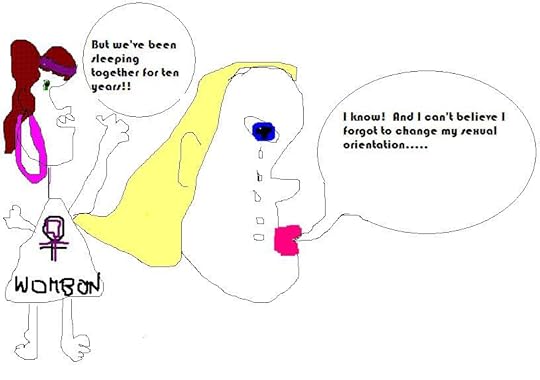
Biphobia runs rampant in gay and lesbian communities.
Lesbians desert their bisexual friends, women they used to hang with when said women dated a woman, when they begin dating a man.
Gay men think bisexual men just need the right man to come out.
Why do people struggle with bisexuality?
There’s the old canard about a bisexual leaving their spouse for an entire gender. “Oh, she’ll leave me for a man.”
Or the myth that bisexuals can’t be monogamous or they are more sexual.
Right.
I have found great solidarity and comfort with bisexual people. Besides the fact that we were once last in the old lgbt abbreviation, bisexual people understand what it’s like to labor under the cudgel of choice, a club carved out of fear.
Choose an orientation. Choose a community. Choose a gender.
Bisexuality is a valid choice. Full stop.
The cartoon above I drew more than a dozen years ago. Can you tell from how poorly drawn it is?!?
My sarcastic sense of humor already peeks through, a style I would pursue through many of my cartoons.
June 10, 2017
Transgender Man Shares Powerful Words About Body Shame
I spent many years pursuing a body fantasy.
Truly I believed hormones and some time would give me a GQ body. When that didn’t happen, a result of genetics, food preferences and lack of exercise, I thought my body was the problem, a mistake that propelled me through years of body shame, internalized transphobia, weird food regimes and overall self-loathing.
June 9, 2017
Transgender Gender Revolt (NSFW Version)
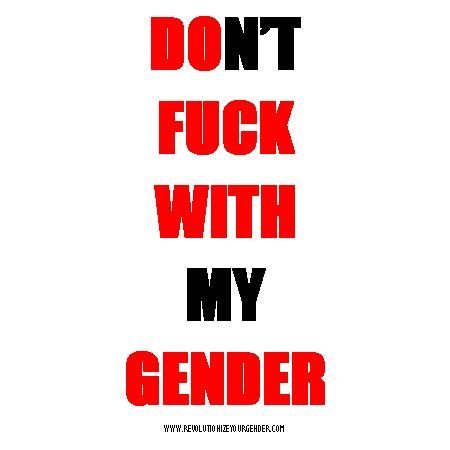
Way back in 2010 I created a website called Revolutionize Your Gender.
I had wanted to disseminate slogans that made us transgender people feel fabulous while also causing nontransgender people to question their own gender, if only for just a little bit.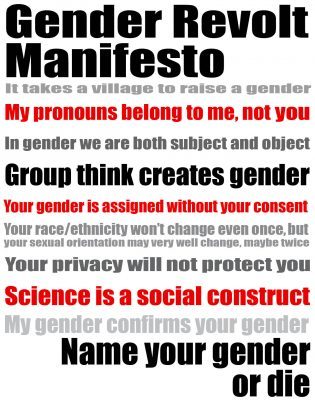 This design was part of a series I created. As I work through old wordpress drafts I will see if I can publish some of the other slogans I created.
This design was part of a series I created. As I work through old wordpress drafts I will see if I can publish some of the other slogans I created.
The gender revolt manifesto was the all-encompassing, master slogan design document of this effort.
At the time, I lacked the stubbornness to see the project through to a better, different place. I suffer from shiny chicken syndrome. The new and shiny will always draw me away from the old and boring. This is a theme that runs through my adult life, though I did change my gender, which in retrospect represents a significant contribution.
The slogans still seem applicable today, which may or may not be a good thing.
June 8, 2017
Transgender Revolt Manifesto
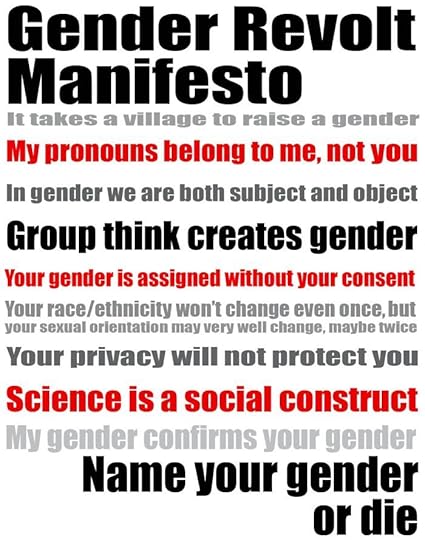
I created this manifesto in 2010.
We deserve an unapologetic revolution, one in which we display our fierceness and fabulousness. This manifesto seemed like a way to add my three cents to the effort.
This image is free to distribute, post on your website, blog site, print out and distribute where ever you think it needs to happen. I’m also including a PDF file which you can download for FREE: Gender Manifesto in PDF form.
May these upcoming months bring more calm and happiness and gender revolution in your life.
June 7, 2017
Transgender Man Revisits His First Days on Hormones in 1996
Yep, 1996 it was. Clinton, Friends and mom jeans ruled the land.
Those times seem like ancient history and as though they happened yesterday. The length of time I’ve been living as a man prompted to come out of retirement and begin sharing my experiences and observations with younger transgender, transsexual and gender queer people.
If nothing else, I can offer a view of a rather longer now that seems conventionally acceptable, with snapchat, twitter, Facebook and other social media outlets driving our need for instant gratification.
June 6, 2017
An Improved and Unusual Transsexual Origin Metaphor
 In Color: A Natural History of the Palette, Victoria Findley writes that color arises through oscillating electromagnetic waves – comprising us, our world and our universe – absorbing and rejecting various “colors” to arrive at the “color” we see.
In Color: A Natural History of the Palette, Victoria Findley writes that color arises through oscillating electromagnetic waves – comprising us, our world and our universe – absorbing and rejecting various “colors” to arrive at the “color” we see.
“Red,” for example, oscillates in such a way as to absorb blue and yellow and reject red. Thus we see red.
Then I applied this phenomena to gender:
As a transsexual man, I oscillate in such a way as to absorb female, feminine and various other types of gender, and reject masculinity and/or male, which is why I/we see male.
Unscientific for sure. But I think it makes a nifty alternative metaphor to the born-in-the-wrong body trope.
Transsexuality gives me the freedom to tell whatever story I want about why I am the way I am. People may not believe me, but at least I get them thinking.
What other theories – wacky or humble – have you folks offered up? How have you transformed your stories over the years? Are you more serious or impish?
June 5, 2017
The Truth About Why Transsexuals Hate Gender Identity Disorder
The real reason many transsexual and transgender people hate the DSM and GID?
We don’t want to be perceived as crazy.
I am NOT Craazzzyyy!!!
Transsexualism, to be treated legally by the medical establishment, needs a diagnosis. In my case, and most typically for most transsexuals, I think, therapists diagnosed me with gender identity disorder (GID).
GID is a psychological diagnosis, as is another diagnosis I have been given, transsexualism.
When I started hormones in 1996, GID enraged me. I didn’t have a psychological problem, people with bipolar disorder or schizophrenia had psychological disorders.
“There is nothing psychologically wrong with wanting to change my gender!”
I had a medical problem and believed my interests as a transsexual female to male would be best served by creating a medical diagnosis, i.e. an endocrine disorder, for example.
A medical diagnosis would surely be better than a psychological one. A medical diagnosis had little social and medical baggage, I thought.
Being lumped together with people with autism or bipolar disorder terrified me.
I wasn’t demented, deranged or unhinged.
A deep seated fear of Crazy bubbled up from somewhere within my socialization. All my middle-class fears about not fitting in and being different was like adding gasoline to a fire.
Not me, nope. Just an ordinary, taller-than-average female to male transsexual in great need of hormones.
The system of gender socialization created the problem, I railed. The problem lay with society, not my mental state or mental health.
A Funny Thing Happened on the Way to a Disability Rights Meeting
I possessed no ability to see the flaw in my logic.
If I believed a system of gender socialization created behaviors some people deemed normal and others not-normal, mightn’t that also be true for other psychological diagnosis?
No. I wasn’t crazy, just pursuing a right I believed belonged to every human being, the right to define and express gender as each person desires.
Then I became aware of disability activism and the neurodiversity movement, an approach to disability that sees neurological conditions as a result of variations in the human genome.
Wait. What?
Psychological disorders aren’t disorders at all unless considered by therapists, psychiatrists and the general public.
A person doesn’t need to be cured of their autism or tourette’s or bipolarity, neurological states that carry heavy social approbations, but accepted as part of the diverse human experience.
The striking similarities between this argument and transsexuals argument regarding unencumbered access to hormones free of social controls failed to impact me immediately.
I understood the arguments of the neurodiversity movement, and I’d like to be able to say today how I was struck smart instantly, but I would be lying if I said that.
In truth I bumped around my own internalized ableism.
Our society profoundly hates and loathes people with different-than-normal neurological conditions.
We joke about them, fear them, round them and murder them, corral them in institutions and betray them repeatedly with shock therapies, water treatments and all kinds of tortures more suited to an Inquisition chamber, not a modern medical establishment.
Oh, and if the person is also transsexual and taking hormones, we’ll be sure to take away their hormones, anytime we want.
Just because we can.
When the Corners Don’t Meet
When I learned medical authorities, particularly doctors, men and women sworn to do no harm, confiscated hormones from patients presenting with other issues/problems/concerns related to their neurological condition, my confusion began to lift.
Seizing hormones is a cruel punishment for a transsexual. How does taking them away from someone who feels suicidal make them feel less suicidal?
Around this same time a dear friend with an exceptionally strong form of bipolarity gave permission for several rounds of ECT or shock treatments. Doctors convinced this person of the efficacy of these treatments.
They ultimately went through several rounds, then stopped. We spoke not long after that.
“I’m sorry but there will be entire months, and maybe even years, of our relationship I won’t remember. I’ll probably never remember.”
Then this person said words that changed my life.
“You’re my memory keeper now.”
I couldn’t square this deal anymore.
What that FtM don’t to warrant a death sentence from people who are supposed to help? Or my dear, dear friend?
Why must we fix different neurological states?
When the objective goal is to make a person normal, perhaps we need to change normal.
At this point I had come full circle.
As a transsexual, I hated normal and realized disability and neurodiversity activists did as well.
One or Two Things I’ve Learned
My fear of being diagnosed with a psychological disorder is arbitrary and results from my wrong-headed beliefs.
Now I’ve learned psychiatric treatments often center around making a person productive, which I think codes out as “go earn the system some profits,” or unitary or stable, whatever that means.
Psychiatric treatments seek to make neurologically diverse people their kind of normal.
I can relate.
A therapist once asked me if I had ever tortured animals, all because I needed his professional okay to pursue top surgery.
The questions and tests and interviews facilitated by the diagnosis of gender identity disorder often seem more about the clinicians than me.
Now I’ve learned psychotherapeutic communities want control. They want to mold us into an image in which they see themselves. Whether or not we survive such extrusions, who cares? We’ll get a stamp of “normal” or we should die trying.
But the most important thing I’ve learned is that a diagnosis is a diagnosis.
Whether the diagnosis is medical or psychiatric, I must still navigate through a system of channels and locks controlled by people who may or may not have my interests in mind.
Medical diagnosis don’t offer better solutions. People with diagnosis of cerebral palsy, for example, or dystonia, can, and are, treated like children by clinicians.
I’ve learned that if you are a black man fighting against a system out to kill you, you’ll probably get diagnosed as schizophrenic.
I’ve learned what happens to a white woman fighting against the malaise of confined, middle-class womanhood.
Either way the cure – whether the diagnosis is schizophrenia or severe under stimulation – doesn’t address the problem, which is racism and misogyny.
Now I’ve learned few circumstances exist that warrant denying a person hormones because they have an additional neurological condition.
I’ve learned a person’s gender dysphoria and another neurological state can follow parallel paths and never intersect. Most therapists I’ve known misunderstand this phenomena, believing that gender can’t be independent of any other diagnosis, even a medical one.
I find it difficult to believe psychiatry a value-neutral proposition. Too many therapists have feed me and my people loads of crap. I’ve had to eat my share of shit sandwiches when it comes to managing my transsexualism, but I’ve always chosen to eat them.
It’s different when someone is shoving it down your throat, while sitting on your chest with their hands around your throat, implying you are abnormal because you struggle to eat the sandwich.
When I really listened to disability activists, sitting with my prejudices and discomforts, I realized a diagnosis is a diagnosis.
Now I’ve learned a medical diagnosis doesn’t make things better for people. A diagnosis of cerebral palsy or dystonia can, and does result, in being treated by like a child by clinicians.
Mostly I’ve learned how desperate middle-class people are for everyone to fit it, get along and keep a low profile.
When I worked at a social work school, a new coworker once called me in a panic.
“A man is sitting in the common area, shouting and biting his fist.”
“He has Tourette’s syndrome,” I told her after walking past the man to her office.
“We know him,” I said.
She smiled, sort of.
The social norming of my employer told her she needed to accept him. He had a right to sit in the common area and shout and bite his fist.
“Oh. Okay.”
Her upbringing, however, suggested a different outcome.
Middle-class people prize quiet and social conformity.
Crazy is a very bad thing among the middle class. Your head is broke.
Now I realize my head is broke, too, when examined through the lens of extreme middle class blandness, gender conformity and the DSM.
Whether a little bit or a lot, a broke head is still broken. I needs diagnosis to get fixed.
When I fear crazy and rail against gender identity disorder and makes claims that I’m not crazy, I’m not really doing anything to change a system I say I hate.
The problem isn’t people who are neurologically different from me. The problem is the system that wants me to believe they are the problem.
Let’s work on changing the system, a twisted, violent thing that really is broken.
The Real Reason Transsexuals Hate Gender Identity Disorder
The reason many transsexual and transgender people hate the DSM and GID?
We don’t want to be perceived as crazy.
When I started hormones in 1996, the psychological diagnosis of gender identity disorder used to enrage me. I didn’t have a psychological problem: “I’m not crazy!”
“There is nothing psychologically wrong with wanting to change my gender!”
I had a medical problem and believed my interests as a transsexual female to male would be best served by creating a medical diagnosis, i.e. an endocrine disorder, for example.
A medical diagnosis would surely be better than a psychological one. A medical diagnosis had little social and medical package, I thought.
I really feared the label being lumped together with people with autism or bipolar disorder.
A deep seated fear of Crazy worried its way into my psyche. I said things about transsexuality and the DSM and psychological disorders that now make me cringe.
God I was just a snotty, ableist jag off. Truly.
Now I know this fear is misguided.
Now I’ve learned a diagnosis is a diagnosis.
Whether the diagnosis is medical or psychiatric, I must still navigate through a system of channels and locks controlled by people who may or may not have my interests in their sights.
Now I’ve learned psychiatric treatments often center around making a person productive, which I think codes out as “go earn the system some profits,” or unitary or stable, whatever that means.
Psychiatric treatments seem to want to create cardboard facsimiles, not treat human beings.
I can relate. The questions and tests and interviews facilitated by the diagnosis of gender identity disorder often seem more about the clinicians than me, managing my therapist’s gender by offering responses I know they’ve wanted to hear.
Medical diagnosis don’t offer better solutions. People with diagnosis of cerebral palsy, for example, can, and are, treated like children by clinicians.
When I really listened to disability activists, sitting with my prejudices and discomforts, I realized a diagnosis is a diagnosis, and better to change the system.
I am solidarity with mental health activists, advocate for complete, low and no cost access to all necessary mental health treatments and believe in more varied work options that allow a person to work in environments conducive to managing their cognitive states. (Who among us as often wondered why those of us who can sit at office jobs, have to sit doing very little – facebooking and tweeting and gchatting -because we’ve finished our day’s work in 90 minutes? Why can’t the corporatists, who are supposed to be smarter than we are, just pay us a day’s wage for 90 minutes of our time?)
Now I’ve learned few circumstances exist that warrant denying a person hormones if they also have a second, psychological diagnosis.
A person’s gender dysphoria another mental health diagnosis can follow parallel paths and never intersect. Most therapists I’ve known misunderstand this phenomena, believing that gender can’t be independent of any other diagnosis.
Now I’ve learned the psychotherapeutic communities want control. They want to mold us into an image in which they see themselves. Whether or not we survive such extrusions, who cares? We get a stamp of “normal.”
And if you are a black man fighting against a system out to kill you, you’ll probably get diagnosed as schizophrenic.
Or maybe you’re a white woman fighting against the malaise of confined, middle-class womanhood.
Either way the cure – whether the diagnosis is schizophrenia or under stimulating – doesn’t address the problem, which is racism and misogyny.
I find it difficult to believe psychiatry a value-neutral proposition. Certainly it can be helpful. Pharma drugs can improve people’s lives, including mine.
Too often the unexamined response is fear and control.
When I worked at a social work school, a new coworker called me in a panic.
“A man is sitting in the common area, shouting and biting his fist.”
“He has Tourette’s syndrome,” I told her after walking past the man to her office.
“We know him,” I said.
She smiled, sort of.
“Oh. Okay.”
The social norming of my employer told her she needed to accept him. He had a right to sit in the common area and shout and bite his fist.
Her upbringing suggested a different outcome.
Middle-class people prize quiet and social conformity.
Crazy is a very bad thing among the middle class. Your head is broke.
Now I realize my head is broke, too, when examined through the lens of extreme middle class blandness, conformity and the DSM.
With my broken head and big mouth, I gladly speak in solidarity with other people living with a psychiatric diagnosis.
Whether a little bit or a lot, a broke head is still broken.
June 4, 2017
Transgender Super Hero/ine Asks: What Do You Know About Gender?
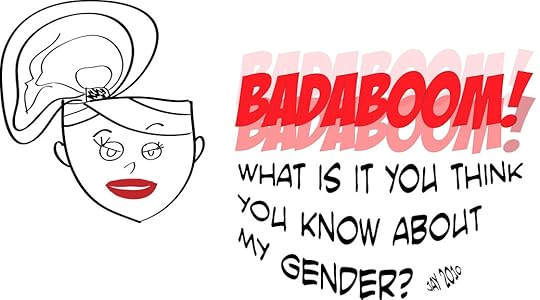
We need transsexual and transgender superheroes.
That realization prompted me to spend time honing my drawing skills, something I had neglected to do when I began cartooning in 2006. Cartooning became my primary visual outlet for about five years, at which time I stopped doing it. But I have created a body of work which makes me smile even today, and even given how badly I drew many cartoons.
When I realized we needed transsexual and transgender superheroes and super heroines, I wanted to do justice to my imaginary figures for justice. The cartoon above represents one result.
We can’t rely on other non-transgender people to create our images and art and words for us. We have to do it ourselves. My attempts fail greatly, obviously.
I hope that by sharing my work with you, more talented gender queer people will be motivated to create and share their own work.
A google search for transsexual or transgender returns pages offering definitions by trans supportive organizations or articles by mainstream magazines, publications that want to get clicks, motivating them to publish pieces directed at nontransgender audiences (“Transgender Men See Sexism from Both Sides”).
My work seeks to change this reality. If we create more and publish and share more on all social media platforms, we will eventually dominate the first page of search returns.
I probably won’t succeed. One of us will, eventually. I’m happy to do my part to roll the boulder along. If you create, please publish and share, and help us move the boulder forward.

